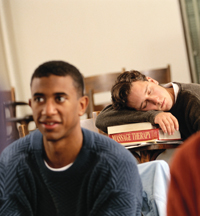
Features
Practice
Technique
The other side of the table: Fall 2003
Monday, 8 am: the treatment class lecture is about to begin. One quick look around the classroom to assess the overall mood level.
September 22, 2009 By Alois Nikodym RMT
Monday, 8 am: the treatment class lecture is about to begin. One quick look around the classroom to assess the overall mood level.

|
|||
|
|
- There is Tracy with her legs crossed, as always, likely to remain in this position for the next 100 minutes. There is Mike in the back row, trying to catch up on his sleep – sitting in almost supine position on his sacrum. Sarah is in front of him, her pen ready to go, furiously copying every word I say. Steve is beside her, neck flexed to 90 degrees referring to the textbook. Angela is bowed to the left, Tina to the right. Wayne switches from left to the right. Monica’s back is twisted and Kristin’s posture defies description. And, of course, almost everyone has protracted shoulders.
- We can almost modify the famous commercial to “I am not only a massage therapy student, but also a future patient.” Yes, while on the way to be able to heal and to correct postural deformities, why don’t we develop a few strategies of our own? That’s the best way to learn, after all, from our own experience. Or, perhaps not.
- There is a number of musculoskeletal problems that seem to follow massage therapy students, and presumably other students too, while spending hours every week for two years or more in the lecture environment. The most common, based on our observation and experience, are:
The Top 10 (apologies to Dave)
- Kyphosis: the unanimous winner
- Anterior head carriage: close second
- Torticollis: not the congenital one
- Iliopsoas contracture: I can’t get up again
- ITB contracture: partially due to low income cycling
- Carpal tunnel syndrome: write, write, write
- Scoliosis: any which way you can
- Tension headaches: sometimes combined with teeth grinding
- Low back pain: location? You name it
- General low level insanity: out of our scope of practice
Inevitable as these conditions seem, there are many ways of preventing these common student aches. There are several strategies teachers are using to break the classroom monotony and get the muscles moving:
Advertisement
- Long lectures should be combined with practical demonstrations and student exchanges;
- Stretch breaks can be easily incorporated into lectures.
- Make students aware of the above conditions;
- Friendly reminders of “sit straight,” “lean back,” etc;
- Avoid endless dictations;
- Demonstrate bad postural habits and their dangers;
- Recommend home care exercises for individual students;
- Postural “Challenge” game – students with the best posture are rewarded;
- Personal posture evaluations of students by a teacher or other students;
- Postural self evaluations and quizzes;
- “Freeze” game, where students observe bad posture in others.
Print this page
Advertisement
Stories continue below
Related